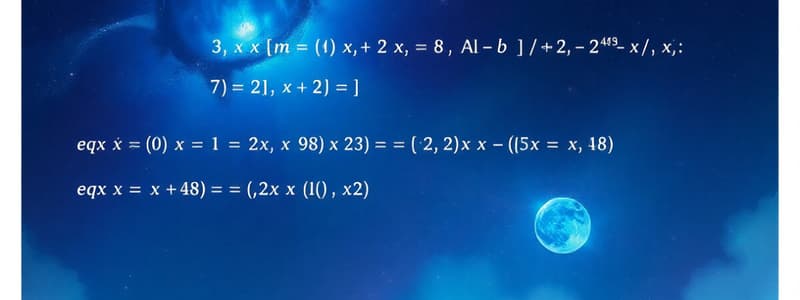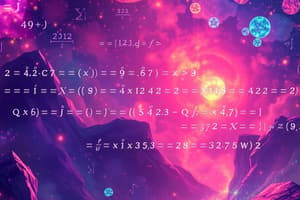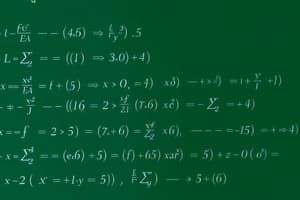Podcast
Questions and Answers
Which of the following algebraic structures is best suited for representing quantities that may change or are unknown?
Which of the following algebraic structures is best suited for representing quantities that may change or are unknown?
- Variables (correct)
- Coefficients
- Constants
- Operators
In the algebraic expression $5x^2 + 3y - 8$, which term is correctly identified as a constant?
In the algebraic expression $5x^2 + 3y - 8$, which term is correctly identified as a constant?
- $-8$ (correct)
- x and y
- $3y$
- $5x^2$
What distinguishes an algebraic expression from an algebraic equation?
What distinguishes an algebraic expression from an algebraic equation?
- An expression includes an equals sign, while an equation does not.
- An equation is always simpler than an expression.
- An expression can only contain variables; an equation can only contain constants.
- An equation includes an equals sign, while an expression does not. (correct)
What is the primary goal when solving an algebraic equation?
What is the primary goal when solving an algebraic equation?
Which characteristic defines a linear equation?
Which characteristic defines a linear equation?
Which method is generally not used to solve quadratic equations?
Which method is generally not used to solve quadratic equations?
Why is it important to perform the same operation on both sides of an equation when solving for a variable?
Why is it important to perform the same operation on both sides of an equation when solving for a variable?
Given the quadratic equation $ax^2 + bx + c = 0$, what part of the quadratic formula determines the nature of the roots?
Given the quadratic equation $ax^2 + bx + c = 0$, what part of the quadratic formula determines the nature of the roots?
What is the primary goal when solving a system of equations?
What is the primary goal when solving a system of equations?
In solving systems of equations, under what condition is the elimination method most effective?
In solving systems of equations, under what condition is the elimination method most effective?
Which operation requires reversing the inequality sign when performed on both sides of an inequality?
Which operation requires reversing the inequality sign when performed on both sides of an inequality?
Which of the following operations is not applicable to polynomials?
Which of the following operations is not applicable to polynomials?
According to the rules of exponents, how should the expression $x^5 / x^2$ be simplified?
According to the rules of exponents, how should the expression $x^5 / x^2$ be simplified?
What is the simplified form of $\sqrt{48}$?
What is the simplified form of $\sqrt{48}$?
What is the purpose of rationalizing the denominator?
What is the purpose of rationalizing the denominator?
If $2^y = 8$, what is the value of $log_2(8)$?
If $2^y = 8$, what is the value of $log_2(8)$?
Using properties of logarithms, how can the expression $log_b(mn)$ be rewritten?
Using properties of logarithms, how can the expression $log_b(mn)$ be rewritten?
What is the defining characteristic of a function?
What is the defining characteristic of a function?
In the function notation $f(x)$, what does 'x' typically represent?
In the function notation $f(x)$, what does 'x' typically represent?
Which of the following correctly describes the domain of a function?
Which of the following correctly describes the domain of a function?
Flashcards
What is Algebra?
What is Algebra?
Branch of mathematics using symbols and rules to manipulate them.
What are Variables?
What are Variables?
Symbols representing quantities without fixed values.
What are Constants?
What are Constants?
Fixed numerical values that do not change.
What are Coefficients?
What are Coefficients?
Signup and view all the flashcards
What is an Algebraic Expression?
What is an Algebraic Expression?
Signup and view all the flashcards
What is an Algebraic Equation?
What is an Algebraic Equation?
Signup and view all the flashcards
What does it mean to Solve an Equation?
What does it mean to Solve an Equation?
Signup and view all the flashcards
What is a Linear Equation?
What is a Linear Equation?
Signup and view all the flashcards
What is a Quadratic Equation?
What is a Quadratic Equation?
Signup and view all the flashcards
What is Factoring?
What is Factoring?
Signup and view all the flashcards
What is the Quadratic Formula?
What is the Quadratic Formula?
Signup and view all the flashcards
What are Systems of Equations?
What are Systems of Equations?
Signup and view all the flashcards
What is the Substitution Method?
What is the Substitution Method?
Signup and view all the flashcards
What is the Elimination Method?
What is the Elimination Method?
Signup and view all the flashcards
What is an Inequality?
What is an Inequality?
Signup and view all the flashcards
What is a Polynomial?
What is a Polynomial?
Signup and view all the flashcards
What is an Exponent?
What is an Exponent?
Signup and view all the flashcards
What is a Radical?
What is a Radical?
Signup and view all the flashcards
What is a Logarithm?
What is a Logarithm?
Signup and view all the flashcards
What is a Function?
What is a Function?
Signup and view all the flashcards
Study Notes
- Algebra uses symbols and rules to manipulate those symbols.
- Symbols represent quantities without fixed values, called variables.
- Algebra is a unifying thread in almost all mathematics.
Basic algebraic operations
- Addition, subtraction, multiplication, and division are fundamental in algebra.
- Operations are performed on variables and constants.
- Constants have fixed numerical values.
- Algebraic expressions combine variables, constants, and operations.
- 3x + 5 is an algebraic expression, where x is a variable, and 3 and 5 are constants.
Variables and constants
- Variables, usually letters, represent unknown or changeable values.
- Constants are fixed numerical values that don't change.
- Coefficients are numerical or constant quantities multiplying the variable in an expression, e.g., 7 in 7y.
- In the expression 7y, 7 is the coefficient and y is the variable.
Expressions vs. equations
- An algebraic expression combines variables, constants, and operations, without an equals sign, like x^2 + 2y - 3.
- An algebraic equation states that two expressions are equal, indicated by an equals sign, like x + 5 = 10.
Solving equations
- Solving an equation means finding the value(s) of the variable(s) that make it true.
- The goal is to isolate the variable on one side of the equation.
- This is achieved by performing the same operations on both sides to maintain equality.
Linear equations
- A linear equation is one where the highest power of the variable is 1.
- The general form is ax + b = 0, where a and b are constants and x is the variable.
- Solving linear equations involves isolating the variable using inverse operations.
Quadratic equations
- A quadratic equation is one where the highest power of the variable is 2.
- The general form is ax^2 + bx + c = 0, where a, b, and c are constants and a ≠ 0.
- Factoring, completing the square, and the quadratic formula can solve quadratic equations.
Factoring quadratic equations
- Factoring involves expressing the quadratic expression as a product of two linear expressions.
- For example: x^2 + 5x + 6 = (x + 2)(x + 3)
- Setting each factor equal to zero determines the solutions.
Quadratic formula
- Solutions for x in a quadratic equation (ax^2 + bx + c = 0) are given by: x = (-b ± √(b^2 - 4ac)) / (2a)
- The discriminant (b^2 - 4ac) determines the nature of the roots.
Systems of equations
- A system of equations is a set of two or more equations with the same variables.
- Solving means finding values of the variables that satisfy all equations simultaneously.
- Solving methods include substitution, elimination, and graphing.
Substitution method
- This method solves one equation for one variable.
- Substitute that expression into the other equations.
- Solve the resulting equations for the remaining variables.
- Substitute the values back to find the values of the other variables.
Elimination method
- This method Multiplies equations by constants so that the coefficients of one variable are opposites.
- Add the equations to eliminate that variable.
- Solve for the remaining variable.
- Substitute the values back to find the values of the eliminated variable.
Inequalities
- Inequalities compare two expressions using symbols like <, >, ≤, ≥, ≠.
- < (less than), > (greater than), ≤ (less than or equal to), ≥ (greater than or equal to), ≠ (not equal to)
- Solving inequalities involves finding values of the variable(s) that satisfy the inequality.
Properties of inequalities
- Adding or subtracting the same value from both sides does not change the inequality.
- Multiplying or dividing by a positive value does not change the inequality.
- Multiplying or dividing by a negative value reverses the inequality.
Polynomials
- Polynomials consist of variables and coefficients, involving addition, subtraction, and non-negative integer exponents.
- Example: 4x^3 - 2x^2 + x - 7
Operations with polynomials
- Polynomials can be added, subtracted, multiplied, and divided.
- Adding or subtracting involves combining like terms.
- Multiplying polynomials involves using the distributive property.
Exponents
- An exponent indicates how many times a base number is multiplied by itself, e.g., x^3 = x * x * x.
Rules of exponents
- Product of powers: x^a * x^b = x^(a+b)
- Quotient of powers: x^a / x^b = x^(a-b)
- Power of a power: (x^a)^b = x^(a*b)
- Zero exponent: x^0 = 1 (x ≠ 0)
- Negative exponent: x^(-a) = 1 / x^a
Radicals
- A radical (√) indicates the root of a number; the square root is most common.
- √9 = 3 because 3 * 3 = 9.
Simplifying radicals
- Simplifying radicals involves factoring out perfect squares, cubes, etc.
- Example: √20 = √(4 * 5) = √4 * √5 = 2√5
Rationalizing the denominator
- Eliminating radicals from the denominator of a fraction involves rationalization.
- Typically, multiply the numerator and denominator by the conjugate of the denominator to rationalize.
Logarithms
- Logarithms are the inverse operation to exponentiation; if b^y = x, then log_b(x) = y.
- b is the base
- x is the argument
- y is the exponent
Properties of logarithms
- Product rule: log_b(mn) = log_b(m) + log_b(n)
- Quotient rule: log_b(m/n) = log_b(m) - log_b(n)
- Power rule: log_b(m^p) = p * log_b(m)
- Change of base formula: log_b(a) = log_c(a) / log_c(b)
Functions
- A function relates inputs to permissible outputs, with each input related to exactly one output.
- The input is the argument, and the output is the value.
Function notation
- Functions are denoted by f(x), where x is the input variable.
- The output value of the function for a given input x is represented by f(x).
Domain and range
- The domain is the set of all possible input values (x) for which the function is defined.
- The range is the set of all possible output values (f(x)) that the function can produce.
Studying That Suits You
Use AI to generate personalized quizzes and flashcards to suit your learning preferences.




